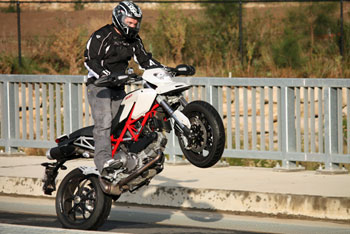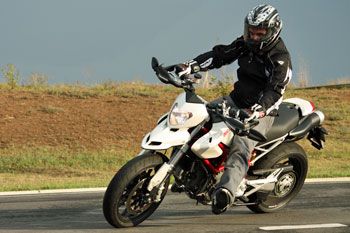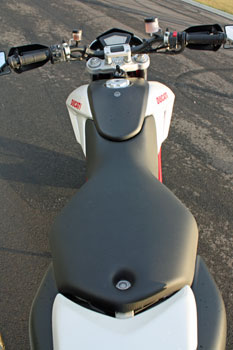MotoOnline.com.au gets hyperactive on Ducati’s 2009 model Hypermotard 1100, sneaking in a real world test.

2009 DUCATI HYPERMOTARD 1100 SPECIFICATIONS
ENGINE
Engine type: L-Twin cylinder, 2 valve per cylinder Desmodromic, air cooled
Bore x stroke: 98 x 71.5mm
Displacement: 1078cc
Compression ratio: 10.5:1
Transmission: Six speed
Power (claimed): 90hp @ 7750rpm
Torque (claimed): 76ft-lbs @ 4750rpm
CHASSIS
Frame type: Tubular steel Trellis frame
Front suspension: Marzocchi 50mm fully-adjustable upside-down fork
Rear suspension: Fully-adjustable Sachs monoshock
Wheelbase: 1455mm
Wheels (front / rear): Five-spoke in light alloy 3.50 x 17 / Five-spoke light alloy 5.50 x 17
Tyres (brand/front/rear): Bridgestone BT-015 / 120/70 ZR17 / 180/55 ZR17
Brakes (front / rear): 2 x 305mm semi-floating discs, radially-mounted Brembo calipers / 245mm disc, single caliper
DIMENSIONS
Weight (claimed): 179kg
PURCHASE DETAILS
Price: $18,990+orc
Colour options: Red or Pearl White
Test bike from: Ducati Australia (www.ducati.com.au)
My first experience on Ducati’s Hypermotard 1100 came at Eastern Creek International Karting Raceway last year after being invited to Hyper Day to celebrate the model’s one year anniversary.
Despite being released in Australia back in August 2007, it seems like just yesterday that the Hypermotard was a concept model, and I still haven’t grown tired of the sharp shape of the bike complete with its duckbill front-end.
It was recently announced at the EICMA Motorcycle Exhibition in Milan that the Hyper would be receiving an overhaul for 2010, meaning that I’d only just snuck in a real world test of the first version before it’s replaced.
With a 1078cc L-twin engine strapped into Ducati’s customary tubular steel Trellis frame complete with a haul of exotic componentry, the 179-kilogram Hypermotard is a sharp-handling bit of machinery with a grunty engine to match.
It’s a playground that invites riders to muck up, creating the ultimate hoon machine that begs for short bursts of speed with flowing turns, not to mention the wheelies that you can pull on demand.
But Ducati’s Hypermotard isn’t just a motorcycle for fanging around on, it’s more than capable of being used as a weekend traveller (not too far, though), weekday commuter, or even a garage mantelpiece – it’s that hot.
There’s ample room for a passenger and plenty of space for some luggage, although you probably wouldn’t want to travel around the country on it if you had the option for a less focussed ride.
The seating position on the 1100 is made up of off-road style tapered handlebars that perch you over the front wheel, with a long, wide seat provided for seating comfort. It’s got stumpy rubber footpegs and the handlebars are surrounded by hand guards complete with the indicators moulded into them and mirrors mounted from each side.
It’s yet another vital aspect of the bike that creates somewhat of an extreme cockpit, yet it’s relatively comfortable as you sit up straight when riding. You just have to be aware that more than an hour or so in the saddle will cause you to get a numb rear-end.
Mounting the foldable mirrors from the side of the handlebars is a unique part of the Hyper, and I’ll admit that I somewhat questioned their usage before rolling out of Ducati Australia’s headquarters.
I was proven wrong almost immediately after a few adjustments of their positions, and they are every adjustable by the way, because the rear vision was quite good apart from a few vibrations when on the gas and in the higher sections of the rpm.
The folding aspect of the mirrors comes in ultra handy when you’re in a tight squeeze when fitting the bike into the garage, too.
The digital instruments are easy to read and adjust via a switch on the left handlebars, featuring a speedometer, rev counter, clock, maintenance schedule, oil temperature, oil pressure warning light, battery voltage, fuel reserve warning light, trip fuel, indicator light, neutral light, injection system diagnostics, lap time memory storage, automatic light-off function, and an immobiliser.
It also comes ready for the Ducati Data Analyser system, which is available from Ducati as an optional extra at an increased cost.
Personally, I’ve long been a fan of the Hypermotard concept and love the supermotard segment of motorcycling, so it’s only natural for me to be thrilled with the looks of the Hypermotard. Not all eyes are sold on it, but for me, it’s a winner.
Having a Pearl White test bike with a red frame and Ducati tank logo to match was right up my alley as I also love the white 848, and the black wheels mounted on this bike set it off nicely.
The handling of the bike once clock some kays is typically rigid as per most Ducatis I’ve swung a leg over, with your body position weighted over the front tyre – not too dissimilar to the Streetfighter.
It takes a little while to build confidence in feeding the bike some initial lean angle as it tends to react very quickly, meaning it’s an all or nothing approach that’s required when cornering on this particular bike.
That doesn’t mean you need to go fast, it just means that once you commit to leaning it over then chances are that it’s going to turn tight and fall into the corner quite quickly.
Once used to its precise nature, you can corner and change direction blissfully on smooth sections of road, only really getting upset on sharp bumps as the suspension bounces off them.
The suspension is stiff and matches the rigid chassis, with very little sag being felt through the Marzocchi fork or Sachs shock absorber, meaning that you can feel every inch of rubber planted to the tarmac via the Bridgestone BT-015 tyres.
Tighter corners are awesomely enjoyable once you gain confidence in turning the bike quickly, taking advantage of the powerful Brembo front brakes as the weight distribution stays balanced while you adjust your speed for each turn.
One of the only downsides to the bike is that the rear brake has a tendency to fade in warm conditions when you’re using it a lot, and for me that’s a real problem because I always use the back stopper.
Its stability at speed is also up to par apart from if you hit a pesky bump without recognising it beforehand, and its weight and overall size do give it a greater sense of stability compared to your conventional single-cylinder motards.
Engine-wise it’s a ripper, featuring a smooth torque curve that creates a wheelie monster at the slightest twist of the throttle, making the exits of tight, low-gear corners a highlight of any ride.
It’s not geared too short though, with a lengthy freeway stint proving a cinch for the Hypermotard 1100, allowing me to cruise along at the usual freeway speeds in sixth gear carrying around 4000rpm of the 11,000 that the rev counter reads.
The power that’s extracted from the big-bore engine comes on precisely as you apply the gas, accelerating up until around 8000rpm before seemingly levelling out in its power output.
I was actually surprised not only with the amount of power that it has on tap while accelerating up through the gears, but also the bursts of speed that it is capable of producing when in top gear and you’re looking to overtake another vehicle. It’s impressive.
Heat gets quiet high around the engine area in the warm weather that we’ve been experiencing lately, transferring to the seat and your legs on longer rides, but it’s nothing unbearable and I’d be more than willing to deal with it should I find a spare $18,990+orc waiting to be outlaid on a new bike.
There’s no denying that the Ducati Hypermotard looks the part and goes the part, and now I’m even more exited to get my hands on the EVO models next year as it’s hard to imagine the Bologna-based manufacturer outdoing themselves by far over the current model. Not only that, but the all-new 796 is going to be incredibly good too if it follows in its big brother’s footsteps.
With a reduced weight and added ponies, the 2010 Hypers are primed to be rippers, but for those who have this current model or are looking at adding one to the fleet, you can be more than satisfied with your purchase.
THE S MODEL HYPER
There are two different models of the Ducati Hypermotard available, with the standard 1100 joined by the up-spec 1100 S model for those who are searching for that bit extra.
The standard model retails for a few less grand than the S model’s $22,490+orc, but the question is, is the bang worth the extra bucks?
Extras on the S include the Ducati Data Analyser as standard equipment, lightweight forged Marchesini wheels that take two kilograms off the overall weight of the bike (179kg to 177kg), higher spec Kayaba 48mm forks, an Ohlins shock absorber to replace the Sachs unit, Brembo Monobloc front brake calipers, and plenty of carbon-fibre bling.
Pirelli Diablo Corsa III tyres also replace the standard version’s Bridgestone BT015 tyres.
Back to the original question of is it worth it, well I think it is.
In my experience on the S versus the standard model at Eastern Creek Karting Raceway, the S suspension is a little bit more responsive to changes and reacts well to extreme use that the Hypermotard is designed for, while the lightweight wheels improve cornering immensely.
Braking power is much increased in both power and feel, delivering superbike-like stopping power to the Hypermotard.
Either way, if you’re looking for supermotard satisfaction, you can’t really go wrong with the Hypermotard.











Newsletter